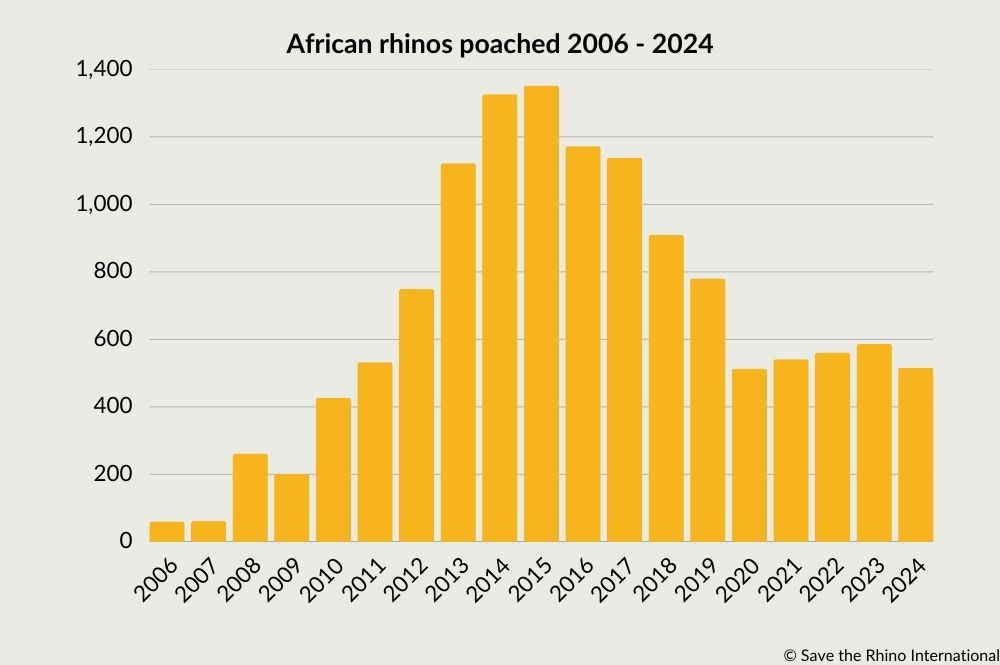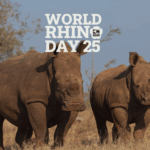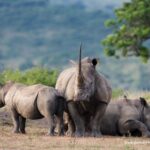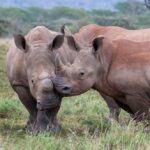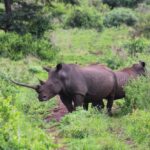The current rhino poaching crisis began in 2008, with increasing numbers of rhino killed for their horn throughout Africa until 2015. Thankfully, poaching numbers have decreased across the continent since the peak of 1,349 in 2015. Yet, at least one rhino is still killed every day: there is a lot more that we must do.
South Africa holds the majority of the world’s rhinos and has been the country hit hardest by poaching criminals, with more than 1,000 rhinos killed each year between 2013 and 2017. However, it’s not the only location targeted by international gangs. Recent reports from Indonesia state that as many as 26 Javan rhinos have been illegally killed in recent years.
South Africa: A rhino poaching hotspot
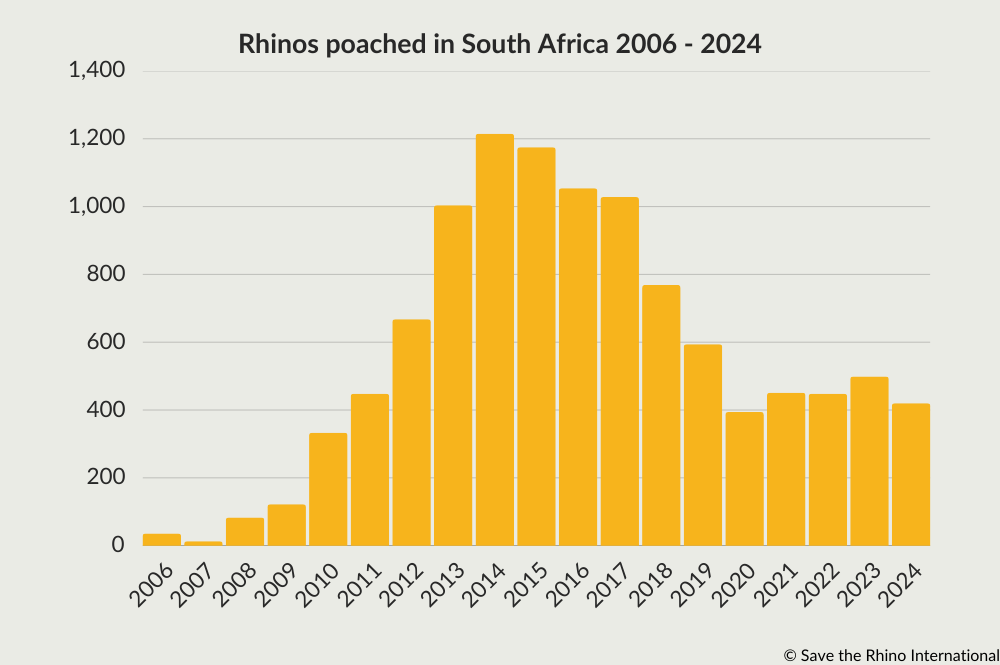
In 2024, 420 rhinos were killed in South Africa, a welcome decrease of more than 15% compared to 2023. Yet organised crime remains a significant threat to rhinos in the country. Rhino poaching is not merely the work of opportunistic criminals; it is part of a complex web of illicit networks that span national and continental borders. The people involved undertake different forms of illegal activities, from tracking and killing rhinos in protected areas to smuggling their horns and sourcing global buyers. Disrupting these intricate networks requires multifaceted approaches and international partnerships.
KwaZulu-Natal (KZN) remains the hardest-hit Province, although recent interventions, including dehorning have contributed to a reduction in poaching losses. Whilst dehorning alone is insufficient to protect rhino populations, this initiative combined with other efforts, has been crucial in achieving a poaching decline of nearly 30% in KZN compared to the previous year, with 232 rhinos poached in the province in 2024.
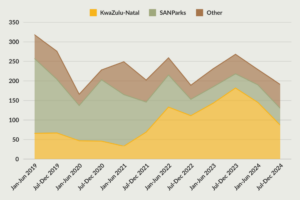
In 2021, rhino poaching increased in South Africa for the first time in six years. It’s likely that this change was due to the impact of the Covid-19 pandemic. As lockdowns were in force across the world, and in particular, curfew laws in place in South Africa, it would have been much harder for poachers to get into a reserve to kill a rhino and then smuggle its horn out of the country, without being noticed. Unfortunately, this meant that as those restrictions started to lift, criminal syndicates started to seize their opportunities to find rhinos again.
Our CEO, Dr Jo Shaw, shared, “Organised crime remains a serious threat to rhinos, other wildlife and the people who protect and live alongside them. Syndicates continually adapt their tactics and areas of focus, and co-ordination is key to ensure can get ahead. International collaboration and sustained investment into best practise tools, including anti-money laundering investigations, are needed to dismantle the dangerous criminal networks involved.
Strong convictions, such as the eighteen-year sentence achieved through forensic financial investigations under Project Blood Orange, send a powerful message that tackling wildlife trafficking also disrupts other serious crimes, including human and drug trafficking. “We must keep up the pressure to protect rhinos and derail the organised crime cartels profiting from this crisis,” Dr Shaw emphasised.
Rhino populations, particularly in key strongholds such as Kruger National Park, in South Africa, have fallen dramatically. They’ve had no time to recover from ruthless poaching that’s taken place throughout the last decade. The long-term impact of the poaching crisis, and the extended periods of drought, are taking their toll. Without urgent action, their numbers could dwindle.
One of the challenges that the ongoing poaching crisis brings is that it diverts attention from other actions that are important for rhinos to thrive in the future. While anti-poaching measures are still a high priority, it’s important that we don’t forget the other tools in the box: biological management, community engagement, capacity building, national and international coordination, and putting in place the long-term sustainable financing needed for important rhino conservation programmes.
South African poaching explained
South Africa has by far the largest population of rhinos in the world and is an incredibly important country for rhino conservation. From 2007-2014 the country experienced an exponential rise in rhino poaching – a growth of more than 9,000%. Kruger National Park suffered heavy poaching losses through this time, and the government and international donors have channelled ever more funding and resources into securing the Park. Despite these extra protection measures, the impact of such intense poaching has caused Kruger’s rhino population to drop by 60% since 2013. However, in recent years the number of rhinos poached in Kruger has declined significantly.
Kruger’s rhinos have declined by
59%
since 2013
Rhino populations are at tipping point. We cannot afford to lose any more rhinos: we must do everything possible to protect remaining populations to help their numbers increase.
It is extremely encouraging that South Africa is continuing to boost efforts to arrest and prosecute poaching criminals; stopping corruption and speeding up prosecution processes continues to be critically important if we are to truly tackle this horrific illegal trade.
The wider African context
The current poaching crisis actually began in Zimbabwe, where the difficult socio-economic and political climate facilitated rhino poaching. Once the easy pickings were taken in Zimbabwe, poaching gangs turned their attention to neighbouring South Africa, which in turn saw huge increases in poaching from 2009-2014.
Since 2006
12,824
rhinos have been poached in Africa
Around 2013, the South African crisis spread to other countries in Africa. First Kenya was hit hard: its worst year for poaching was in 2013 when 59 animals were killed (more than 5% of the national population). In 2015, both Zimbabwe and Namibia suffered losses: Namibia lost 80 rhinos to poaching, up from 25 in 2014 and just two in 2012, while in Zimbabwe at least 50 rhinos were poached in 2015, more than double the previous year. For Africa as a whole, the total number of rhinos poached during 2015 was the highest it had been in two decades.
How your support helps
We can’t protect rhinos without your help. There is no magic bullet to solve the poaching crisis: it will take a mix of the best tools we’ve got.
Having well-trained and equipped rangers is an important start. So too is secure habitat and good rhino monitoring, so that we know exactly where the rhinos are, and how they’re breeding. Making sure that the communities living near rhino habitats see and feel the benefits of conservation is another critical factor in preventing people from turning to poaching or encroaching on rhino habitat. Education is important – both in countries where rhinos live, but also in Asia, where consumer demand for rhino horn is highest. Captive breeding or intensive management for the rarest species is also vital to maintain genetic diversity and prevent the species from dying out.
With your support, we can decrease these poaching numbers in the future.
If you can, please consider a donation today.
can purchase a foam mattress for a ranger camping on patrol
can purchase a new pair of boots that will last in the field
could help purchase a ranger's uniform


